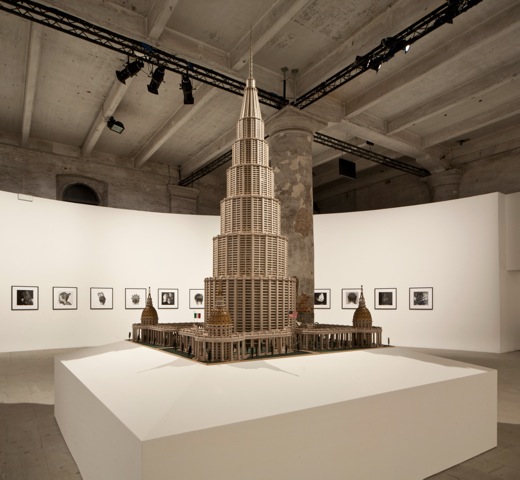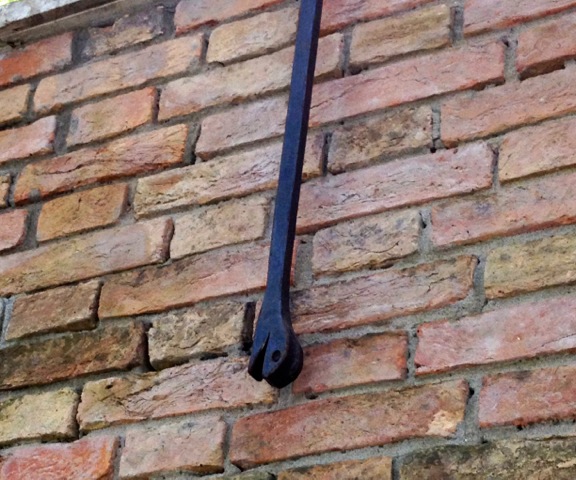Cruising to the Lido in Venice, I passed daily between two iconic sights that challenge the splendor of the eternal city...
...the ever-present James Franco in a brightly colored Gucci advertisement looming over Piazza San Marco....
... a hermaphroditic figure with a male head and a pregnant female torso astride a pedestal on Isola de San Giorgio Maggiore.
The Cinema and Arte sections of La Biennale di Venezia 2013 marked Italy as a leader of a renaissance in global culture, even as it revived the nation from Berlusconi's descent.
This year's Italian curator Massimilliano Gioni was inspired by the self-taught Italian-American artist Marino Auriti, whose imaginary Il Palazzo Enciclopedico (The Encyclopedic Palace) museum "was meant to house all worldly knowledge, bringing together the greatest discoveries of the human race, from the wheel to the satellite."

The centerpiece of the Arsenale was a model of Auriti's ziggurat styled Palazzo Enciclopedico (The Encyclopedic Palace), a 136-story building that was meant to stand seven hundred meters tall over sixteen blocks in Washington, D.C. (Photo by Francesco Galli; Courtesy la Biennale di Venezia.)
Yet, the 55th Exposizione Internazionale d'Arte will be remembered for spotlighting Carl Jung, the visionary exiled due to the very mystical bent celebrated in the Biennale.
Alberto Barbera's second outing in his return as festival director after being ousted by the spoils of Berlusconi's rise to power shook up the 70th Mostra Internazionale d'Arte Cinematografica. The hoped for surprised expressed by the celebrated Italian filmmaker Bernardo Bertolucci , head of the international jury, was fulfilled by way of awarding the Golden Lion for Best Film...
...to the Italian director Gianfranco Rosi for his documentary Sacro GRA, the title a play on the Holy Grail, the mystical legend of the exiled sacred feminine. Photo courtesy of La Biennale di Venezia.
La Biennale Arte 2013 honored the Swiss father of archetypal psychology via his triumphant artistic breakthrough, Red Book, the centerpiece of the rotunda entrance of the Giardini Central Pavilion.
Extending the dialogue over at the Swiss Pavilion, was a serpent encasing the inner galleries and climbing the outer wall. This ingenious integration of inner/outer demonstrates the ultimate goal of 21st century art.

Valentin Carron's wrought iron "You they I you" brings a Jungian universal archetype of transformation into a new sculptural context.
Together with the violent expression of the 70th Venice Film Festival, the transformative vision of the Biennale Arte made for an exhilarating ride,
The second day premiere of director Emma Dante's viscerally intractable Via Castellanna Bandiera established a haunting Kali like specter over the entire film festival. Countless deaths of the female body on the huge Venice screens later...
...the Coppa Volpi went to Elena Cotta for her unforgettable performance of death-as-life willing death. Photo courtesy of La Biennale di Venezia.
The Arsenale rescued contemporary art from being held hostage to the international marketplace. It buckled against the slick commercial art fair driven output of the last two decades by redefining art in the 21st century as the product of inner obsessions. These unruly "cabinets of curiosities" came about by navigating personal cosmologies; the objective seemed to be the quest for the universal mythology embedded in Auriti's urban adaptation of the ziggurat reflecting the ever-present origin of the Sumerian Sacred Marriage Rite.
Dark Matter materialized: Phyllida Barlow's primordial sculpture in Il Palazzo Enciclopedico, la Biennale di Venezia. (Photo by Francesco Galli. Courtesy la Biennale di Venezia).
While dark energy was being channeled through such personal visions in the art on view in Venice this year, it ran amok as violence in a film festival where the female corpses kept piling up to the unquantifiable in the case of James Franco's adaptation of Cormac McCarthy's Child of God. Yet, the underground transformation of this American film's necrophiliac protagonist astutely mirrored the paradigm leap of its director - from Gucci model/movie star to boundary smashing pioneer of a holistic aesthetic.
"I use extreme subjects to get to the universal," explained Child of God director James Franco, here with his actor Scott Haze, whose visceral tour de force embeds Franco's novel cinema with its literal body extremity: the written word -- both orally and on the page.
The Central Pavilion of the Gardini established a strong foundation for Il Encyclopedico Palacio through the revival of artists who dared to seek a universal system of knowledge by plunging into the mystical. Such visionary artists as Emma Kunz who utilized her holistic mandalas for healing...
Emma Kunz determined that her art would only be accepted and understood when the world was ready, as appears it is today, with her Biennale appearance alongside that of the Swedish mystical artist Hilma of Klint written up in same January 2013 Art Forum issue with the multimedia wonder Aldo Tambellini, who explored the mystical in the 1960s in the context of space exploration.
And speaking of space exploration, George Clooney launched the film festival into the mystical with his opening quip...
"Sandy and I did a lot of Bikram Yoga together."
Sandra Bullock and George Clooney in Gravity. (Photo still courtesy of Warner Brothers.)
...in response to a question about how the actors preparation for their full scale submersion reflecting Elie During's philosophy of "floating time".
George Clooney besieged after the Gravity press conference with Alfonso Cuaron, the cowriter, co-producer, coeditor and director.
Mexicans have an innate understanding of dark energy, given their immersion into the mythology of Quetzalcoatl, the feathered serpent, and native belief in magic. With Gravity, the Cuarón brothers arrive in an Ouroboric full circle from their Best Screenplay award in the 2001 Venice Film Festival for Y Tu Mama Tambien.
The female sexual liberation of their earlier film evolves into a full-scale narrative of life/death/rebirth in outer space with Sandra Bullock's transformational performance of a female astronaut who surrenders into "floating time" to hallucinate her way into a literal awakening propelling her space vehicle into a 21st century rebirth.
The evolutionary narrative reflects the (r)evolutionary process of this amazing film, establishing a new paradigm from the altered perspective of human beings rotating in space while balancing technology with the human heart/hand to create an inner/outer holistic aesthetic serving the breakdown of boundaries between art and entertainment.
The 21st century icon of the hieros gamos (sacred marriage) was transmitted even in the posters by way of the chord attaching the male and female astronauts, symbolizing a populist depiction of gender equality we experience in the film as the sacred marriage of heaven and earth, imaged in the detail...
...of Swedish mystical painter Hilma of Klint
...taking us back to Sandra Bullock's contained characterization of dark energy exploration leading to a feminine awakening inside the womb-like interior of a space capsule.
Now, that is the true Holy Grail!
The serpent awakening the human heart in the transformation into the hieros gamos in the visionary painting of the Russian artist Friedrich Schroder-Sonnenstern (1892-1982), long an "Outsider Artist" favorite, and now finally an "Insider Artist" with a prescient presence in Il Palazzo Enciclopedico, la Biennale di Venezia.
All photos, unless otherwise noted, are by Lisa Paul Streitfeld and used with the permission of la Biennale di Venezia.
Lisa Paul Streitfeld, a philosopher and art critic based in Berlin, is a Ph.D. candidate at the European Graduate School.
